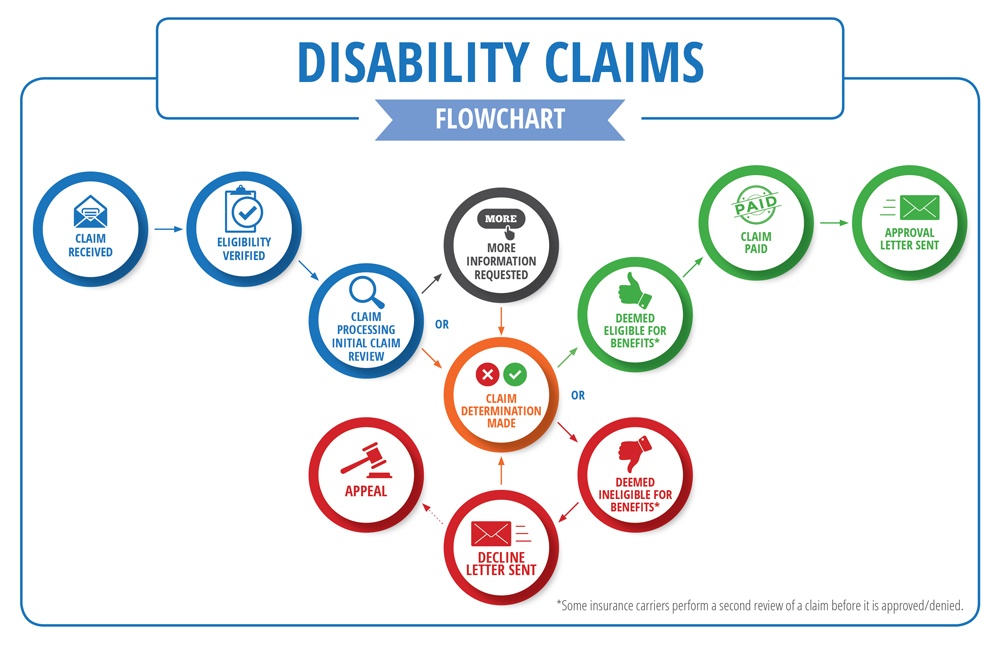The disability claims process is a lot more complicated than just the employer/employee submitting a claim application and then waiting for an approval/denial decision.
Here’s an overview of how the claim process works, why your claim might be taking longer to process, how to manage employee expectations, and what to do to help ensure a smooth claims process.
How Claims Work
Getting insight into how claim decisions are made can clarify why the process can be quick for some claims and slower for others. Check out the flowchart below to see what happens during the disability claim process.
Two Reasons Why Your Claim May be Taking Longer than Anticipated
1. Incomplete Claim
To start the claim determination process, the insurance carrier must have a complete claim. Since each claim is unique, what constitutes a complete claim varies from one case to another.
Let’s start with the basics: the claim application is the first step toward a complete claim. The claim application form consists of three sections: the Employer, Employee, and Physician Statement. Each form needs to be completed in full by the appropriate party and submitted to the insurance carrier.
Important: Until the carrier receives all three parts of the form the status of a claim is pending. That means no work is being done on the claim. If any portion of the application is missing, or a form is not completed in its entirety, the status will remain pending.
Based upon the paperwork submitted, a claims examiner performs an initial claim review. During this review, the claims examiner looks over the submitted information and decides if it is enough to substantiate the claim.
Medical records may or may not be needed to make a claim decision. If a physician does not submit medical records when they complete their portion of the claim application, a claim may be approved without them. Other claims may necessitate medical records to help make a decision. The claim process could be slowed down or halted (pending claim) waiting for records.
If no additional information is required, the carrier may perform a second review (to assure accuracy) before making a determination. Once the review is complete, a letter of determination (either approval or denial) is sent to the employee and copied to the employer.
If the claim is to be denied, the determination letter sent out to the employee and employer will be very different. The employee’s letter will explain in detail the reasons why the claim was denied. It will also contain information how to go about appealing a claim (if the employee elects too). For privacy purposes, the employer’s letter will be more general in nature.
Sometimes during the initial claims review, the claims examiner will decide that more documentation is needed. This might occur if records received refer to other treatments or conditions that were not part of the initial claim documentation. Requested documentation might include medical records, payroll records, or a vocational analysis. If this is the case, a letter will be sent to the employee, outlining what additional information is being requested and a deadline for submission. Telephonic interviews may take place during this time with the employer and/or employee, as well as requests to medical providers. The carrier may also utilize internal or external (vendor) resources such as medical professionals (both general or specialists), vocational case managers, surveillance, etc. to help aid in making a decision.
2. Inaccurate Expectations of Turn-Around Time
Some carriers may have a stated turn-around time for claim processing, but this figure is often mistaken for the total amount of time a claim will take. The stated time is generally how long it takes the carrier to complete the claim determination once the claim is considered complete. As we learned above, the claim is not complete until all requested forms, records, and other information is received by the carrier.
Claim payments are issued or scheduled immediately upon approval. The timeframe for approval may be delayed should the carrier determine that additional information is needed to support the disability (medical records, vocational information, eligibility confirmation, etc.) and that is all dependent upon the unique circumstances of each claim.
Managing Employee Expectations
You truly see the human side of benefits when you work with a disabled employee. They may be sick or in pain, and you want to help them with extra support and encouragement. But the sad fact is that not all disability claims are approved. And that can feel like a sock in the gut. Sometimes employees think that if a doctor tells them that they cannot work, then they will be approved for disability benefits. However, that is not always the case.
The insurance carrier’s job is determining if the employee’s disability, as evidenced by medical records, meets the insurance policy’s definition of disability. For example, does the policy’s definition of disability include own occupation, any occupation, or a combination of both? Can the employee still work in their profession? Are they able to work in any other occupation for which they are qualified for? The carrier looks at a variety of factors including the employee’s occupation, their condition, other comorbid conditions, the plan’s definition of disability, etc.
How You Can Help the Employee
Although most of the claim process is out of your control, there are some things you can do on your end to ensure a smooth transition.
- Complete your part of the form in its entirety.
- Submit your part of the form in a timely manner. Don’t wait for others to submit their portion.
- Let employees know that they may need to follow up with their physician.
- If additional information is requested, promptly handle the request.
And remember that due to the unique nature of each claim, things may need to be carefully reviewed and examined. At times, that process takes longer than anyone can predict.
Struggling with an employee's disability claim? Download our disability claims checklist to help guide you through the process.


